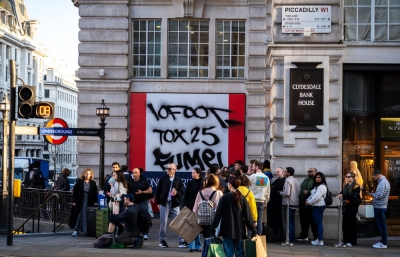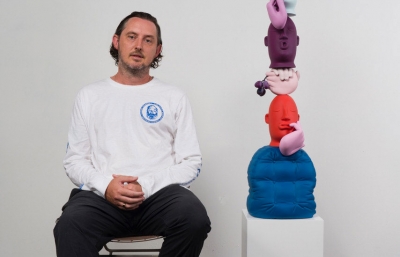Christian Quin Newell
A Dream Sequence
Interview by Doug Gillen from Radio Juxtapoz
As soon as I first read about the practice of London-based Christian Quin Newell, I knew I wanted to interview him. His show there this past summer at Public Gallery was a collection of—and I directly quote—“Cosmological paintings opening up portals to an internal realm informed by Buddhist philosophy, mysticism, meditation, and the dream.” See what I'm talking about?
What immediately grabbed me at the exhibition was the scale of the works. Clearly disproving theories about size, each of these 20 centimeter paintings (nearly 8 inches) spread across the gallery’s three floors packed more than their weight. The whole show was a genre-bending hybrid of environment and character, equally sourcing history and myth. During our conversation at Newell’s new South London studio, I learned about his practice of lucid dreaming and the active role it plays in his creative process.

Doug Gillen: What was the thinking behind your summer show, The Way, this past summer at Public Gallery?
Christian Quin Newell: The thinking behind the show revolves around my dream life, as in my nighttime dreams and around lucid dreaming, as well as the idea of actually learning how to lucid dream. So how do we do that? How do we develop mindfulness and awareness during the day, and have that crossover and influence at night, so that we can become more aware throughout the whole process? The practice is like me being more aware of my day-to-day so that I'm more aware while in the process of dreaming. Tibetan Buddhism, for example, says that if you can become lucid in your dream, basically recognizing that you’re dreaming, it becomes an aha moment.
You mean permanent awareness?
So that you can literally do whatever you want in the dream. Say, you choose to make art in the dream, it's like that process is enhanced sevenfold. It's creating these very strong neurological connections in your brain. The implications are very cool because, to give another example, if you play sports and you can do sports in your lucid state, your mind doesn't differentiate between performance in the waking or the dream life. It's like you actually improve through dreaming, as if you're training extra.

But this theory, and I hope you don’t mind me calling it that, where does this come from? How do you feel it changed your understanding of the art that you're making?
Initially, I was studying art history and I was going through the Renaissance where I was preoccupied with technique and how they did certain things, working through different artists. Then I came across the Surrealists, which was when I was in my teenage years, about 17, 18 and was fascinated by Max Ernst and Salvador Dalí. That was the first time I was being shown that an artist can source themselves; in a sense, they don't need to always look for outside influences or stimuli. You learn how you have this vast ocean of knowledge already within that can be tapped into. In Surrealism, through things like automatic drawing and such, they practiced this. From that, and maybe it wasn't so concrete, I started to record my dreams in a dream diary. I started doing it in 2013.
Describe your dream diary.
I wake up from a night's sleep, and the first thing I try to do is jot down anything and everything in my notebook. It could be super vague. It could even be like, “I think I was dreaming.”

Do you write words or draw sketches?
It could be both. Everyone dreams during sleep, and sometimes, for example, I’ll have four or five dreams a night. Most people don't remember them because they're not interested, and that's the whole thing about it. I use my phone, wake up and just take notes, write things down, and then print them out. But in the days before I used my phone, when I was a lot more invested in it, I would have dream diaries and just draw out the landscape of the dream. After a while, I developed this ability to be able to see the dream from a bird's eye view. At first it was difficult, but then I found the more I did it, the better I was able to do it, to be able to visualize the 3D space for the dream, the architecture of the dream. And then usually after a week or so, I'd revisit it because there was such immediacy that sometimes you need to have some space to let it marinate. Usually what we don't really notice in our waking life ends up manifesting in our dreams. It’s like you take pictures during the day and they're developed in the night, in the dark room of your dreams. I like that and find it quite poetic.
Since you've started this practice, have you found your dreams becoming more interesting, more detailed? Can you attach more meaning to them?
Yeah, definitely.
Is there a direct connection then between the work that we see in the gallery show and the dreams you're having? What a lot of pressure on your sleeping life.
I'm telling you, some days I’ll wake up and think, “Oh, do I even have to write this down?” Literally when you start, the more you do it, the more you get. Let’s talk about it as if there's a dreamer who is sending you letters every night for a dream bank, and most of us are just not reading them. But then one day when we're interested, we're like, “Let me have a little read.” And as soon as you read it, the dreamer is like, “Oh shit, he's reading my list. I'm going to write a bit more juicy content and provide it to him.”
I think you’ve noticed that if you're really stressed, the dreams maybe are not really there. Or maybe you have times when you have more nightmares, and that's actually a good sign because it means that your mind is processing things. It's like, “All right, let's work through this now.” So nightmares are good. I think nightmares are a sign of a healthy mind.
But in terms of the show, yeah, I like to talk about it as a diary of me being interested in dreams, meditation, and spirituality. And having a deadline for the show makes me think, “I want to show you my entries of what I've been thinking about what has come through me in the lead up to this.” And it is an ongoing process, so it just keeps going. It's not like this is the one project and then I move on to something else. I just want to keep it flowing.

What sort of interesting techniques do you use in the studio? If we are talking about getting into your dreams, are there things you practice with your technique to enhance this?
One technique that I have is to use my non-dominant hand. What I found with working with my non-dominant hand, whether it's through pen, ink or paint, is you are allowing the subconscious and unconscious to take over. You know the Rorschach Test? Like the ink blots on the paper? A psychiatrist would tell you to just look at it and then ask what is the first thing that you see? And people say all kinds of different stuff. I've found it's the same thing drawing with my left hand. It's like there's no intention. There's a sense of… letting go of ego in the sense that I don't intend to do anything. I don't have any intention. I just see what comes up. And it takes on a whole new meaning. It’s playful. That sort of helps break down the process a bit for me.

You studied illustration, right? What were your early influences in art?
My mom always brought me to museums and my dad was a musician. He had multiple jobs, and was a bouncer at night. In the day, he would play his guitar and sing, and we'd listen to good music. I didn't think it was possible to make a career just being a painter, so I chose illustration. I was like, okay, I'm going to get a job drawing in an office or something like that. I remember I wanted to be a cartoonist, even though I didn't know what it meant. But the reality was that, when I got to university, it was a lot more about working with other people, working your design to fit the brief or the text. And I hated that because, in a way, I couldn't do it. Some people are really good at working and bouncing off ideas, but I was… I would just say arrogant, I didn’t want to do that.

Looking at your studio situation, it is set up with an illustrator's desk. And surveying the work in the show, a lot of it is small, almost sketchbook size. What determines the scale and what you're working for; how does this size of a piece of paper change how you expect a viewer to interact or engage with it?
On the physical side, I would say that I'd previously been working on pretty big canvases. They would take up the whole space, the whole wall. Two of them would be all I could fit in this studio. The work for The Way was quite small. Having traveled a lot, having also had a lot of shows, working in different studios, I was kind of burnt out in terms of having to produce such big works all of the time.
I needed a moment to just collect myself, as well. The small works were always consistent in my practice. And I believe the smaller works to have the same value as these larger works. Who are we to maintain that bigger is better in terms of work? I realized that I could start to even talk about how works on paper are just as great as works on canvas. You could see it in different cultures, a conversation where, “This work by a Venetian artist is better than this work from a Chinese painter because it's on canvas.” It just doesn't make sense to me. It's nothing to do with the medium. And even paper, for example, I believe someone who worked in conservation told me that paper can last longer than canvas. Canvas is a lot more temperamental to work with over time, and you're working with harsh chemicals and stuff like that. So it's quite refreshing to not have to work with these toxic substances, especially since I've been painting since the age of 18.
@cee_quin // This interview was originally published in our WINTER 2025 Quarterly






